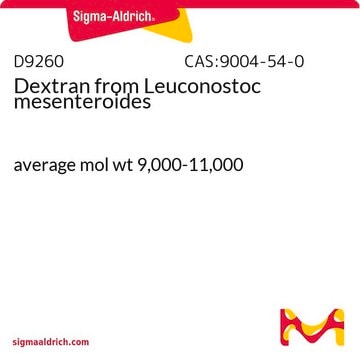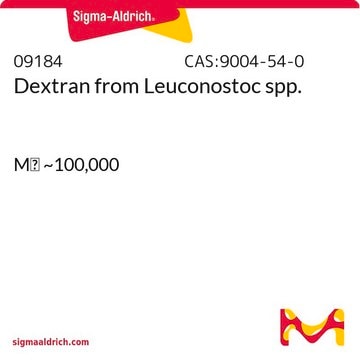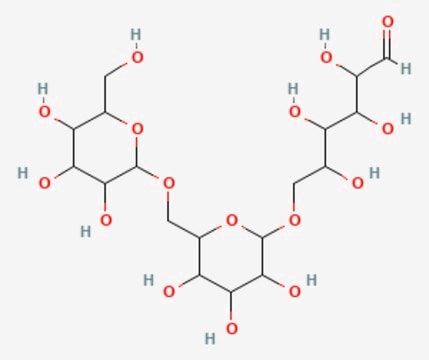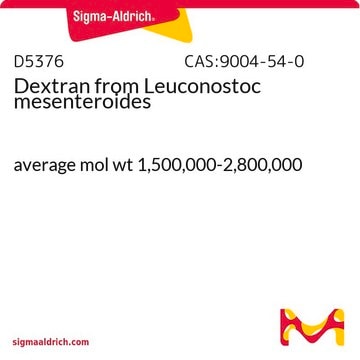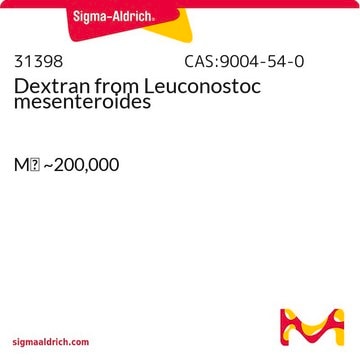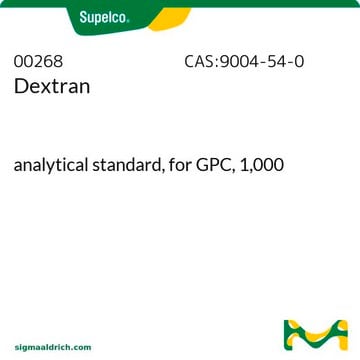31389
Dextrane from Leuconostoc spp.
Mr ~40,000
Synonyme(s) :
DEXTRAN 40
About This Item
Produits recommandés
Source biologique
(Leuconostoc spp)
Forme
powder
Poids mol.
Mr ~40,000
Technique(s)
cryopreservation: suitable
gel permeation chromatography (GPC): suitable
Perte
≤7% loss on drying
Couleur
white
Pf
483 °C ((901 °F ))
Solubilité
water: 1.5, clear, colorless
Absorption
≤0.05 at 375 nm in H2O at 10%
Adéquation
suitable for additive or modifier in the separation of proteins or peptides
Application(s)
advanced drug delivery
agriculture
sample preparation
Température de stockage
room temp
InChI
1S/C18H32O16/c19-1-5(21)9(23)10(24)6(22)3-31-17-16(30)14(28)12(26)8(34-17)4-32-18-15(29)13(27)11(25)7(2-20)33-18/h1,5-18,20-30H,2-4H2
Clé InChI
FZWBNHMXJMCXLU-UHFFFAOYSA-N
Vous recherchez des produits similaires ? Visite Guide de comparaison des produits
Catégories apparentées
Description générale
Application
- to mix with embryo suspension in seawater to prepare the sample for cryo-imaging
- to immerse the tails of zebrafish larvae for cryoimmobilization
- in the synthesis of vinyl sulfone modified dextran (DX-VS)
- in the synthesis of methacrylate functionalized dextran via ester linkage (DX-O-MeA)
- as a supplement in NCTC-135 tissue culture medium to prepare the perfusion medium
Dextran 40 is used in the development of new improved preservation solutions for organ transplantation. Dextran 40 may be used to determine cell tightness and flux parameters across cell layers. Dextran 40 is used as a colloidal plasma volume extender.
Actions biochimiques/physiologiques
-Cryoprotection: Dextran acts as a cryoprotectant by forming a protective barrier around cells and tissues during freezing. This barrier inhibits the formation of ice crystals, which can damage cell membranes and structures.
-Viscosity Control: Dextran can alter the viscosity of solutions by increasing the molecular weight of the solution. This change in viscosity affects the flow properties of the solution, making it useful for controlling the thickness of solutions in various processes.
-Drug Delivery: Modified dextran serves as a carrier for controlled drug delivery. Dextran can encapsulate drugs and release them gradually, enhancing drug solubility and controlling the release profiles to improve therapeutic outcomes.
-Gel Electrophoresis: Dextran increases the density of sample loading solutions in gel electrophoresis. This increased density helps samples sink into the gel matrix, allowing for more precise separation of molecules based on size and charge during electrophoresis.
-Enzyme Stabilization: Dextran stabilizes enzymes by providing a protective environment. It forms a stable matrix around enzymes, enhancing their activity and extending their lifespan in various biochemical reactions. This protection prevents enzyme denaturation and inactivation, allowing enzymes to function more effectively.
Caractéristiques et avantages
- Dextran with an average molecular weight of 40,000
- Freely soluble in Water, DMSO, formamide, ethylene glycol, and glycerol
- Versatile and adaptable for various laboratory and research applications
Autres remarques
Produit comparable
Code de la classe de stockage
11 - Combustible Solids
Classe de danger pour l'eau (WGK)
WGK 2
Équipement de protection individuelle
Eyeshields, Gloves, type N95 (US)
Certificats d'analyse (COA)
Recherchez un Certificats d'analyse (COA) en saisissant le numéro de lot du produit. Les numéros de lot figurent sur l'étiquette du produit après les mots "Lot" ou "Batch".
Déjà en possession de ce produit ?
Retrouvez la documentation relative aux produits que vous avez récemment achetés dans la Bibliothèque de documents.
Les clients ont également consulté
Contenu apparenté
Dextrans are polysaccharides with molecular weights ≥1,000 Dalton, featuring a linear backbone of α-linked d-glucopyranosyl repeating units.
Notre équipe de scientifiques dispose d'une expérience dans tous les secteurs de la recherche, notamment en sciences de la vie, science des matériaux, synthèse chimique, chromatographie, analyse et dans de nombreux autres domaines..
Contacter notre Service technique

